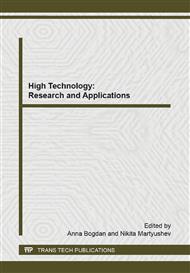[1]
S. Heidenreich, Hot gas filtration – A review, Fuel. 104 (2013) 83-94.
Google Scholar
[2]
M. Abdul Mujeebu, M.Z. Abdullah, M.Z. Abu Bakar, A.A. Mohamad, M.K. Abdullah, Applications of porous media combustion technology - A review, Applied energy. 86, 9 (2008) 1365-1375.
DOI: 10.1016/j.apenergy.2009.01.017
Google Scholar
[3]
K.H. Jack, Sialons and related nitrogen ceramics – Review, Journal of materials science 11 (1976) 1135-1158.
DOI: 10.1007/bf02396649
Google Scholar
[4]
E. Kroke, M. Schwarz, Novel group 14 nitrides, Coordination Chemistry Reviews 248 (2004) 493–53.
DOI: 10.1016/j.ccr.2004.02.001
Google Scholar
[5]
K.L. Smirnov, I.P. Borovinskaya, Combustion synthesis of SiAlON-based ceramic composites, Powder Metallurgy and Metal Ceramics, 42, 11-12 (2003) 596-602.
DOI: 10.1023/b:pmmc.0000022199.34054.90
Google Scholar
[6]
A. S. Maznoi, A. I. Kirdyashkin. Influence of initial parameters of reacting systems on the porosity structure of self-propagating high-temperature synthesis products, Combustion Explosion and Shock Waves. 50, 1 (2014) 60-67.
DOI: 10.1134/s0010508214010079
Google Scholar
[7]
X. Xu, R. Fu, K. Chen, Jose´ M.F. Ferreira, Cost-effective fabrication of porous α-SiAlON bonded β-SiAlON ceramics, Materials Letters. 59 (2005) 2601–2604.
DOI: 10.1016/j.matlet.2005.03.048
Google Scholar
[8]
V. N. Antsiferov, V. G. Gilev, Membrane porous materials from SiAlON, Refractories and Industrial Ceramics. 42, 1-2 (2001) 57-63.
DOI: 10.1023/a:1011301320402
Google Scholar
[9]
J. Yang, J. Yu, Y. Huang, Recent developments in gelcasting of ceramics, Journal of the European Ceramic Society. 31 (2011) 2569–2591.
DOI: 10.1016/j.jeurceramsoc.2010.12.035
Google Scholar
[10]
Z. Hou, F. Ye, L. Liu, Q. Liu, Fabrication of gradient porous b-SiAlON ceramics via a camphene-based freeze casting process, Materials Science and Engineering A 558 (2012) 742–746.
DOI: 10.1016/j.msea.2012.08.094
Google Scholar
[11]
A.S. Maznoy, A.I. Kirdyashkin, Yu.M. Maksimov, Methods for stereometrical analysis of porous penetrable materials morphology, Izvestiya Vuzov - Powder metallurgy and functional coatings. 3 (2011) 44-50. (In Russian).
Google Scholar
[12]
M. Shahien, M. Radwan, S. Kirihara,Y. Miyamoto, T. Sakurai, Combustion synthesis of single-phase β-sialons (z = 2–4), Journal of the European Ceramic Society. 30 (2010) 1925–(1930).
DOI: 10.1016/j.jeurceramsoc.2010.02.022
Google Scholar


